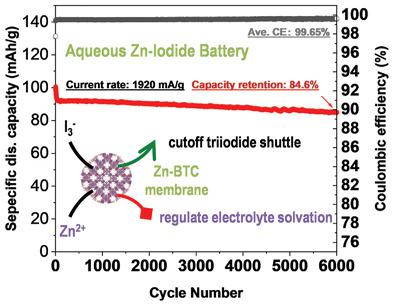当前位置:
X-MOL 学术
›
Adv. Mater.
›
论文详情
Our official English website, www.x-mol.net, welcomes your feedback! (Note: you will need to create a separate account there.)
A Metal-Organic Framework as a Multifunctional Ionic Sieve Membrane for Long-Life Aqueous Zinc-Iodide Batteries.
Advanced Materials ( IF 27.4 ) Pub Date : 2020-08-14 , DOI: 10.1002/adma.202004240 Huijun Yang 1, 2 , Yu Qiao 1 , Zhi Chang 1, 2 , Han Deng 1, 2 , Ping He 3 , Haoshen Zhou 1, 2, 3
Advanced Materials ( IF 27.4 ) Pub Date : 2020-08-14 , DOI: 10.1002/adma.202004240 Huijun Yang 1, 2 , Yu Qiao 1 , Zhi Chang 1, 2 , Han Deng 1, 2 , Ping He 3 , Haoshen Zhou 1, 2, 3
Affiliation

|
The introduction of the redox couple of triiodide/iodide (I3−/I−) into aqueous rechargeable zinc batteries is a promising energy‐storage resource owing to its safety and cost‐effectiveness. Nevertheless, the limited lifespan of zinc–iodine (Zn–I2) batteries is currently far from satisfactory owing to the uncontrolled shuttling of triiodide and unfavorable side‐reactions on the Zn anode. Herein, space‐resolution Raman and micro‐IR spectroscopies reveal that the Zn anode suffers from corrosion induced by both water and iodine species. Then, a metal–organic framework (MOF) is exploited as an ionic sieve membrane to simultaneously resolve these problems for Zn–I2 batteries. The multifunctional MOF membrane, first, suppresses the shuttling of I3− and restrains related parasitic side‐reaction on the Zn anode. Furthermore, by regulating the electrolyte solvation structure, the MOF channels construct a unique electrolyte structure (more aggregative ion associations than in saturated electrolyte). With the concurrent improvement on both the iodine cathode and the Zn anode, Zn–I2 batteries achieve an ultralong lifespan (>6000 cycles), high capacity retention (84.6%), and high reversibility (Coulombic efficiency: 99.65%). This work not only systematically reveals the parasitic influence of free water and iodine species to the Zn anode, but also provides an efficient strategy to develop long‐life aqueous Zn–I2 batteries.
中文翻译:

一种金属有机框架,可作为长寿命水性碘酸锌电池的多功能离子筛膜。
引入氧化还原对三碘化物/碘化物(I中的3 - / I - )成水可再充电锌电池是一种有前途的能量存储资源由于其安全性和成本效益。然而,由于三碘化物的失控和锌阳极上不利的副反应,目前锌碘(Zn–I 2)电池的有限寿命还远远不能令人满意。在此,空间分辨率拉曼光谱和显微红外光谱表明,锌阳极遭受水和碘物种引起的腐蚀。然后,金属有机骨架(MOF)被用作离子筛膜,以同时解决Zn–I 2的这些问题。电池。多功能MOF膜,首先,抑制了我梭3 -上的锌阳极相关寄生副反应,抑制。此外,通过调节电解质的溶剂化结构,MOF通道可构建独特的电解质结构(比饱和电解质中的离子离子缔合更多)。通过同时改善碘阴极和锌阳极,Zn–I 2电池可实现超长寿命(> 6000次循环),高容量保持率(84.6%)和高可逆性(库伦效率:99.65%)。这项工作不仅系统地揭示了游离水和碘物种对Zn阳极的寄生影响,而且为开发长寿命Zn–I 2水溶液提供了有效的策略。 电池。
更新日期:2020-09-21
中文翻译:

一种金属有机框架,可作为长寿命水性碘酸锌电池的多功能离子筛膜。
引入氧化还原对三碘化物/碘化物(I中的3 - / I - )成水可再充电锌电池是一种有前途的能量存储资源由于其安全性和成本效益。然而,由于三碘化物的失控和锌阳极上不利的副反应,目前锌碘(Zn–I 2)电池的有限寿命还远远不能令人满意。在此,空间分辨率拉曼光谱和显微红外光谱表明,锌阳极遭受水和碘物种引起的腐蚀。然后,金属有机骨架(MOF)被用作离子筛膜,以同时解决Zn–I 2的这些问题。电池。多功能MOF膜,首先,抑制了我梭3 -上的锌阳极相关寄生副反应,抑制。此外,通过调节电解质的溶剂化结构,MOF通道可构建独特的电解质结构(比饱和电解质中的离子离子缔合更多)。通过同时改善碘阴极和锌阳极,Zn–I 2电池可实现超长寿命(> 6000次循环),高容量保持率(84.6%)和高可逆性(库伦效率:99.65%)。这项工作不仅系统地揭示了游离水和碘物种对Zn阳极的寄生影响,而且为开发长寿命Zn–I 2水溶液提供了有效的策略。 电池。















































 京公网安备 11010802027423号
京公网安备 11010802027423号